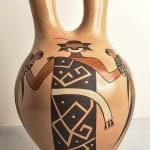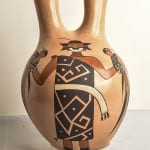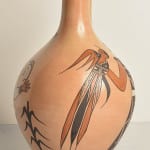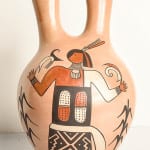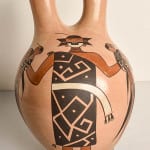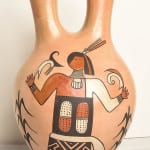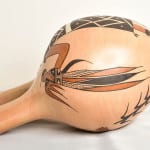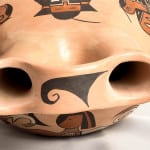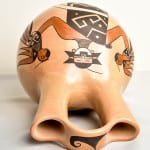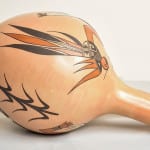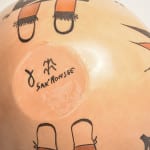Although this collection contains hundreds of Hopi pots, only three others are in the form of a “wedding vase” (1998-03, 2010-04 and 2020-01). The form originated in Santa Clara pueblo but, because of the cute story associated with it, was promoted by Anglo traders and is now made by every pottery-producing pueblo in the American Southwest and a few factories in China. Because the form is not indigenous to Hopi, it does not attract me. The four examples in this collection were purchased because each has an exceptional design.
The form of this vase is graceful and well done. The jar is not heavy, which indicates that the walls are thin. The color is even, with only a slight blush to one spout indicating its traditional firing.
The design on the vase is rooted in Hopi culture, both ancient and modern. Understanding this pedigree requires a fairly complex explanation.
During the first third of the 20th Century, archeologists discovered a series of murals painted in layers in the kivas of ancient pueblos. The murals created a sensation because Anglos were surprised that Native cultures could produce such sophisticated art. The murals remain sensational because of the quality of their workmanship and the complexity of their iconography. The first such discovery was at Kawaika-a at the turn of the century, but the most extensive –and famous—was at the prehistoric Hopi Village of Awatovi excavated in the 1930’s (Watson Smith, 1952, 2005 edition).
Between 1954 and 1962, The University of New Mexico excavated an ancient village site along the Rio Puerco in central New Mexico that had been occupied between 1300 CE and 1475 CE, this later date about 65 years before the Spanish arrived in the area. Anglos called the site “Pottery Mound” because of the hundreds of thousands of pottery shards that cover the area. Under the direction of Dr. Frank Hibben about 800 kiva frescos were discovered and documented at Pottery Mound, though Dr. Hibben halted his work because his method of documentation destroyed the murals.
Published images of ancient kiva murals have inspired numerous Hopi artists, most notably five Hopi men (Michael Kabotie, Delbridge Honanie, Milland Lomakema, Sr., Terrance Talasaima and Neil David, Sr.) who in 1973 formed The Artist Hopid on Second Mesa. Click on the IMG icon below to see one of their murals:
In 1975 Dr. Hibbin published images of the kiva murals he found at Pottery Mound (Hibbin, 1975). Seven years later Michael Kabotie and Delbridge Honanie collaborated on a 6’ X 15’ acrylic on canvas mural commissioned by The Museum of Northern Arizona (catalog # C2417 A-C). Titled “Pottery Mound; Germination,” the painting is an interpretation of the murals found by Hibben and features the images Jean later used on her wedding vase. (Published in Hays-Gilpin, 2006:16-17 and Behnke, 2013:164-165.)
One image on the vase shows a maiden dancing while holding a parrot in each outstretched arm.
Wearing a full-length black manta with square a crook designs, the young woman displays hair whorls indicating that she is an unmarried maiden. A tan mask cover the upper part of her face, indicating her spiritual being. In each hand she holds a graceful Macaw parrot. These birds were never native to the U.S. Southwest, but were imported over hundreds of miles from the tropical forests of Central and South America. Birds and feathers have a central place in the iconography of Native peoples. Macaws with their bright tail feathers must have been especially treasured given the heroic effort needed to transport them by foot over hundreds of miles. Wrapped around the waist of the maiden is a rain sash that is understood by the Hopi to represent female fertility, corn and rain. For hundreds of years this sash has been a feature of pueblo marriage ceremonies and katchina dances. Fringed moccasins protect her feet.
Of the original fresco image, Hibben writes:
“One of the most common motifs of the frescoes is parrots painted in both realistic and stylized forms. In figure 45 (the image used by Jean)…a female dances with a parrot in either hand, probably macaws (Ara macao), a bird usually scarlet in color. This and several other paintings appear to depict live birds and not effigies (1975:60).”
A drawing of this image is reproduced in Hibben (1975:62-63). A photograph of the fresco in newly-found condition is reprinted here:
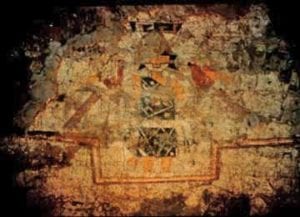
The second personage painted by Jean on vase 2015-06 is reproduced in Hibben’ book and described as a “Highly stylized woman’s figure wearing and elaborate headdress and a necklace with shell pendant holds stylized parrots (1975:53)” On her vase Jean has simplified the headdress and removed the spots that covered the skin of both the original and the Kabotie and Honanie rendition of this image. Moreover in both the original kiva mural and the Kabotie/Honanie painting, this figure is truncated at the waist while the image on Jean’s jar is full-length. The woman on Jean’s vase is presented with her face in profile, hair gathered at the rear and feathers emerging from the hair at the crown of the head. A shell necklace graces the neck, probably with turquoise inlay. . A rain sash also encircles this waist. Above are two oval images representing cobs of corn. Opposite ends of each cob are painted red and white. Below the sash is a black kilt with stepped rain clouds and a linear design. Emerging from the top finger of each hand are white curvilinear elements and joined to these white elements is a curved brown shape (left hand) and a black curved shape (right hand). As we have seen, Hibben interprets these as stylized parrots. Fringed moccasins protect her feet.
Painted in black between the two figures are six-leaved stalks of corn, the basic sustenance of Hopi people. Jean is of the corn clan and similar stalks appear on jar 2010-08 by her in this collection.
Jean might have seen the Pottery Mound images in either the 1975 book, the 2002 MNA painting or the 2006 Plateau magazine that reproduced the MNA painting. One bit of evidence points to Hibben’s 1975 book as the source. We have noted that the original mural image and the MNA painting truncate the second personage on the vase at the waist. In contrast Jean depicts this image as a full body view. The rain sash and black kilt used by Jean on her vase are almost exact replicas of those found on another mural image and reproduced in Hibben’s book (1975:105). Thus vase 2015-06 was produced as early as 1975.


